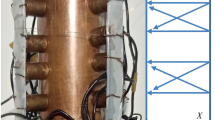Abstract
An analysis for the in situ elastic response of a vibrating-wire stress gage in soft rock (E<105 Mpa) has been accomplished with the use of the finite-element method and approximate analytical procedures. The vibrating-wire stress gage is not a true stressmeter in that it is somewhat dependent on rock-modulus changes. Conventional procedures for calibration include the assumption that this dependency is linear with respect to rock modulus. In this analysis, a nonlinear relationship is demonstrated and an approximate mathematical expression is derived for it. Good agreement is obtained between theoretical calibration factors and test results on laboratory-scale samples with the stressmeter.
Similar content being viewed by others
References
Hawkes, I. and Bailey, W.V., “Design, Develop, Fabricate, Test, and Demonstrate Permissible Low Cost Cylindrical Stress Gages and Associated Components Capable of Measuring Change of Stress as a Function of Time in Underground Coal Mines,” USBM Contract Report No. H0220050 (November 1973).
Nevel, D.E. “The Ring Test, Brazil Test and Strength of Sea Ice,” U.S. Army CRREL Technical Note (July 1969).
Author information
Authors and Affiliations
Rights and permissions
About this article
Cite this article
Fossum, A.F., Russell, J.E. & Hansen, F.D. Analysis of vibrating-wire stress gage in soft rock. Experimental Mechanics 17, 261–264 (1977). https://doi.org/10.1007/BF02324840
Issue Date:
DOI: https://doi.org/10.1007/BF02324840




